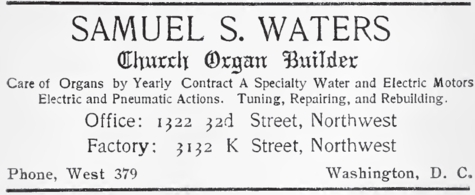 Over the weekend, I had the opportunity to chat with one of the builders who worked on many of the Capitol Hill houses that were fixed up during the 60s and 70s. Watch this space – and the Hill Rag – for more on him and his family, but one of the houses he mentioned piqued my interest. I have written numerous times about manufacturing that was done on the Hill, but I hadn’t heard about any organ factories. It turns out that there was one, and just south of East Capitol street on 10th.
Over the weekend, I had the opportunity to chat with one of the builders who worked on many of the Capitol Hill houses that were fixed up during the 60s and 70s. Watch this space – and the Hill Rag – for more on him and his family, but one of the houses he mentioned piqued my interest. I have written numerous times about manufacturing that was done on the Hill, but I hadn’t heard about any organ factories. It turns out that there was one, and just south of East Capitol street on 10th.
Samuel S. Waters was born in the District of Columbia in about 1875. His father was a plumber living in Georgetown – at the time still separate from the City of Washington. Waters grew up in Georgetown, and it was here that he became an organ maker. His organs were used in many churches in the area, and his name as an organ builder grew.
In about 1910, now married to the former Fannie Fenton, and with a 10 year old son also named Samuel S. Waters, he moved to Capitol Hill. His home was at 109 10th Street SE, while his shop was at 111 10th, an old carriage house set well back from the street.
Waters’s business thrived – to the point where he no longer saw any reason to advertise. While before his move, he had frequently paid for advertising in various publications, he no longer seems to have spent much money in order to get new business. Nonetheless, his organs sold well, and numerous churches across the city boasted of having Waters organs, and the grand Keith’s theater on 15th Street NW was another important beneficiary of the grand sound of a Waters organ.

Ad for the Waters Organ Factory in 1907, before the move to Capitol Hill. Waters apparently saw no need to advertise after the move. (LOC)
Waters was decidedly old school in his work, refusing to add either heat or electricity to his workshop. Instead, all mechanical energy came from a small gas-powered engine, an engine that has since been added to the collection of the Smithsonian Institution.
Along with building organs, Waters also repaired them, and an article in the Washington Post in 1915 describes how he “overhauled and improved” the organ in the First Congregational Church. In doing so, he made “this remarkable old instrument much more effective by changes in the pedal keys, and by inclosing the pipes of the choir organ in a swell box.”
Waters was not just an organ-builder, but also an inventor, receiving numerous patents over the years. While some of his inventions were related to organs, or instruments in general, he also received a patent for a new kind of needle for reading records, one which allowed for multiple channels in one groove. In this, he showed that stereophonic records were possible, about 30 years before they became widely available.
Waters one son, Sam Jr., began as an apprentice to his father but soon veered off into the lumber business, to the point where in his obituary not a single word was wasted about his original work on organs. Instead, he worked his way from shipping clerk to president of the W. T. Galliher company.
In 1963, after Samuel Waters’s death, the organ shop was sold to the developer William Richards, and what had formerly been a carriage house and factory now became a home. With the assistance of the architects Hugg and Drayton, as well as the efforts of the Barnes/Edwards family of carpenters, the space was converted into a remarkable living space. A 1969 article in the New York Times describes its new life as a home with 26-foot ceilings and a balcony. Just last year, this unique house on the hill was featured in the CHRS house tour.
